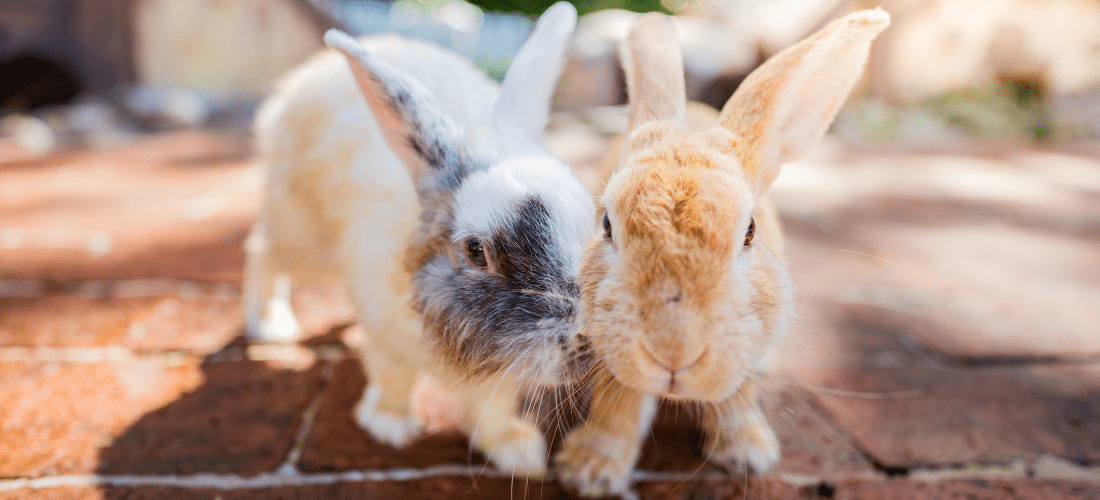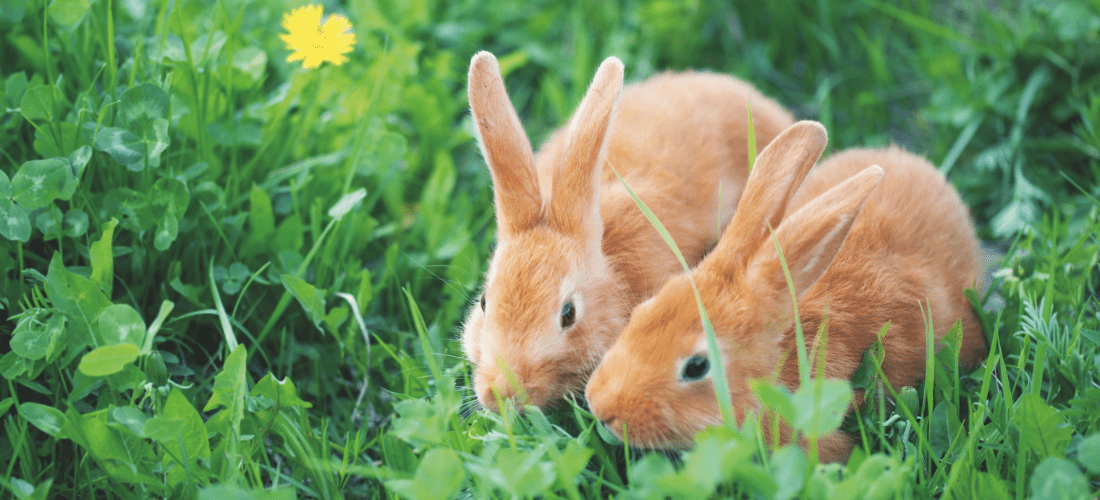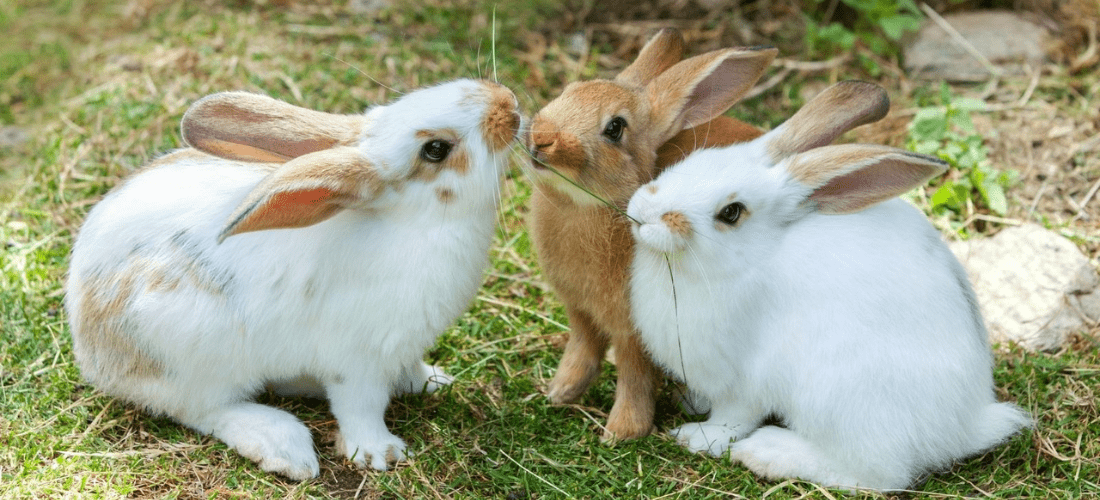Due to their small size, many people underestimate just how much care rabbits need. Often, small animals like rabbits are brought home as pets for children – which can sometimes lead to their specific needs not being met and signs of illness being missed. It also doesn’t help that rabbits are good at hiding that they’re unwell and won’t make it obvious until it’s become much more serious.
The good news is that a lot of the conditions rabbits suffer with are preventable with the right diet and care. Learning to understand rabbits, will help owners identify changes that could be of concern and deal with any problems early on.
To stay happy and healthy, rabbits need access to:
- An unlimited supply of feeding hay.
- Daily portion of rabbit-safe fresh vegetables.
- A small amount of rabbit complete food pellets.
- Clean, fresh water (available in both bottle and bowls).
- Plenty of space to exercise.
- A same-sex or neutered rabbit companion(s).
- Shelter from the weather (if outside).
- A predator-proof enclosure.
- Dust-free bedding.
If you’re new to caring for rabbits, or considering introducing a pair into your family soon, here’s a list of common health issues your bunnies could encounter throughout their lives, how to spot them early on, and how to help prevent them from occurring in the first place.
1. Overgrown teeth
One of the most common dental problems in rabbits is overgrown teeth. This is because, like other small pets (e.g. guinea pigs, hamsters, etc.), rabbits’ teeth never stop growing. Thankfully, it’s very easy to keep your bunnies’ teeth at a comfortable and even length – you just need to provide an unlimited supply of feeding hay (such as Timothy Hay) and most rabbits will be able to wear the teeth down naturally.
Having overgrown teeth not only makes it harder for your rabbit to eat or drink (which can have fatal consequences it left untreated) but it can also cause sharp spurs to develop which cut into the gums and sides of your rabbits’ tongue. In some cases, a rabbit’s teeth may not align properly in their mouth (malocclusion) which stops them from wearing down naturally – regardless of if they’re being fed the right diet. These cases will need regular dental treatments and may result in the teeth needing to be removed.
You should check your rabbits’ teeth regularly so that you can spot issues before they become trickier to deal with. Find out how to check your rabbit’s teeth with our video. If you’re still having trouble, ask your vet to check for you.
Symptoms of dental disease in rabbits:
If your rabbits are showing any of these symptoms, take them to see a vet as soon as possible.
- Overgrown teeth.
- Weight loss.
- A dirty bottom – because grooming becomes difficult and painful.
- Diarrhoea or soft faeces.
- Weepy eyes and white sticky discharge around the eyes.
- Drooling.
- Reduced appetite and picky eating – they may also drop food when eating.
- Tooth grinding.
- A bumpy, painful jaw.
- A runny nose.
- Lethargy (low energy).
If your rabbit stops eating, this is an emergency situation. They are at risk of gut stasis and will need to see a vet immediately.

2. Snuffles (Upper Respiratory Infection)
Don’t be fooled by its cute name, the snuffles (upper respiratory infection) can be a serious rabbit condition and can result in sudden death if not treated early enough. This rabbit illness is mostly caused by the bacteria Pasteurella and Bordetella. Although Pasteurella can be found naturally in your rabbits’ airways (nose and throat), it tends to cause problems when your bunny is stressed, sick, or if their habitats aren’t right for them.
The best way to avoid the snuffles is by keeping stress levels low (by providing same-sex or neutered bunny companions), giving your rabbits enough space to exercise that’s clean and well-ventilated, and making sure that they’re being fed the correct diet. The bacteria can be passed between rabbits directly as well as indirectly via objects, people, clothing, etc. If one of your rabbits is ill, you must keep them away from other bunnies, separate all of their items, and keep things clean (including hands) to not pass anything on. Don’t reintroduce your rabbits until the infected rabbits have recovered completely.
We have a dedicated page on snuffles in rabbits, but below are the warning signs you should look out for when doing regular health checks. Unlike humans, cold-like symptoms in rabbits won’t go away on their own and need to be checked by a vet.
Symptoms of snuffles (URI) in rabbits:
- Weepy eyes.
- Discharge from the nose.
- Sneezing/snuffles.
- Fast breathing/difficulty breathing.
- Wheezing/noisy breathing.
- Low energy, being quieter than usual or hiding away.
- Loss of appetite and weight loss.
- Stained fur on front legs from cleaning weepy eyes and a runny nose.
3. Flystrike
One of the more gruesome conditions rabbits are at risk of is flystrike (‘myiasis’). This life-threatening condition happens when flies lay eggs in your rabbits’ fur, which later hatch into maggots, and burrow under the skin and feed on flesh. Maggots can cause a lot of damage in just one day so contact your vet immediately if you think your rabbits have flystrike.
The main causes of flystrike are warm weather, a mucky bottom (due to diarrhoea, dental issues, arthritis, obesity, dirty enclosures, etc.), and fresh wounds – as flies like to lay their eggs around them. The best way to prevent your bunnies from getting this condition is to keep their homes as clean as possible (by spot cleaning them out at least once a day and deep cleaning regularly) and to keep on top of their daily health checks and grooming.
There are treatments available for rabbits to help prevent flystrike, so you should talk to your vet to find out the best one for your pets. Never use a general insect repellent or flea treatment as many are unsuitable for rabbits and could have fatal consequences if applied to rabbits or used in their environment.
Symptoms of Flystrike in rabbits:
- Maggots in the fur/under the skin.
- Patches of wet fur and fur loss (often around the back end).
- Open wounds or sores containing fly eggs or maggots.
- Lethargy (low energy).
- Eating less.
- A bad smell.
- Collapse.

4. Rabbit-specific diseases
Just like dogs and cats, rabbits require regular vaccinations to help keep them healthy and to prevent disease. Two of the main ones that rabbits can suffer with is Myxomatosis and Rabbit Viral Haemorrhagic Disease (RHD). Sadly, both are devastating for the rabbits affected and are fatal in most cases.
Both diseases are caused by viruses; RHD attacks a rabbit’s internal organs and causes internal bleeding, while Myxomatosis attacks a rabbit’s eyes, skin, lungs, liver, and genitals. The best way to prevent your rabbits from suffering from these nasty diseases is to vaccinate all of your bunnies from 5-7 weeks of age and then every year following.
Other ways to keep your rabbits safe from these diseases are to prevent insect bites (which could transmit the diseases from wild rabbits to pet rabbits) by keeping enclosures clean, covering outdoor rabbits’ living space with mosquito netting if necessary, and talking to your vet about appropriate flea treatments - Only UK licensed flea treatments that are specifically made for rabbits should be used. It’s also a good idea to Rabbit proof your garden to keep wild rabbits out as this is vital to prevent direct transfer of parasites or viruses.
If you’re introducing new rabbits into your home, you should also vaccinate them and keep them away from your existing rabbits for at least three weeks. As always, if your rabbits are showing any concerning symptoms or behaviours, contact your vet to be on the safe side.
Symptoms of Myxomatosis in rabbits:
- Swelling around the eyes, face, ears and genitals.
- Weepy eyes (milky).
- A runny nose.
- Skin lumps, ulcers and scabs on the face and body.
- Low energy (lethargy).
- Difficulty eating or drinking.
- Breathing problems.
- Hot to touch (high temperature/fever).
Symptoms of RHD in rabbits:
- Blood around the nose, mouth or bottom.
- Low energy (lethargy).
- Eating less - which can cause serious problems and even be fatal in rabbits.
- High temperature.
- Sudden death - RHD often develops so quickly that infected rabbits die before their owner notices any symptoms.

5. Skin parasites
Unfortunately, rabbits and other small animals aren’t exempt from picking up fleas, mites and lice. The main ones to be aware of are ear mites, fur mites, fleas, and lice. All of these will make your pet feel itchy and uncomfortable, and if left untreated, can result in painful sores, fur loss, and more. You should always check any new rabbits you plan to introduce to your home to make sure that they won’t be passing on any parasites to your other pets.
Speak to your vet if you’re concerned about your rabbits’ fur or skin and they’ll be able to prescribe a flea or mite treatment suitable for rabbits. Never use flea treatments intended for other animals (e.g. dogs or cats) as they can be poisonous for rabbits. You can also help by keeping your rabbits’ home clean, and grooming them regularly, and providing hay and straw that’s dust extracted and packaged.
Symptoms of skin parasites in rabbits:
- Lots of scratching/overgrooming.
- Fur loss.
- Sore, red, flaky skin.
- Scabs and crusty bits of skin.
- Black specks in fur and on skin.
- Insects crawling amongst the fur.
--
For more tips on looking after your furry-friends, take a look at our rabbit health guide.
